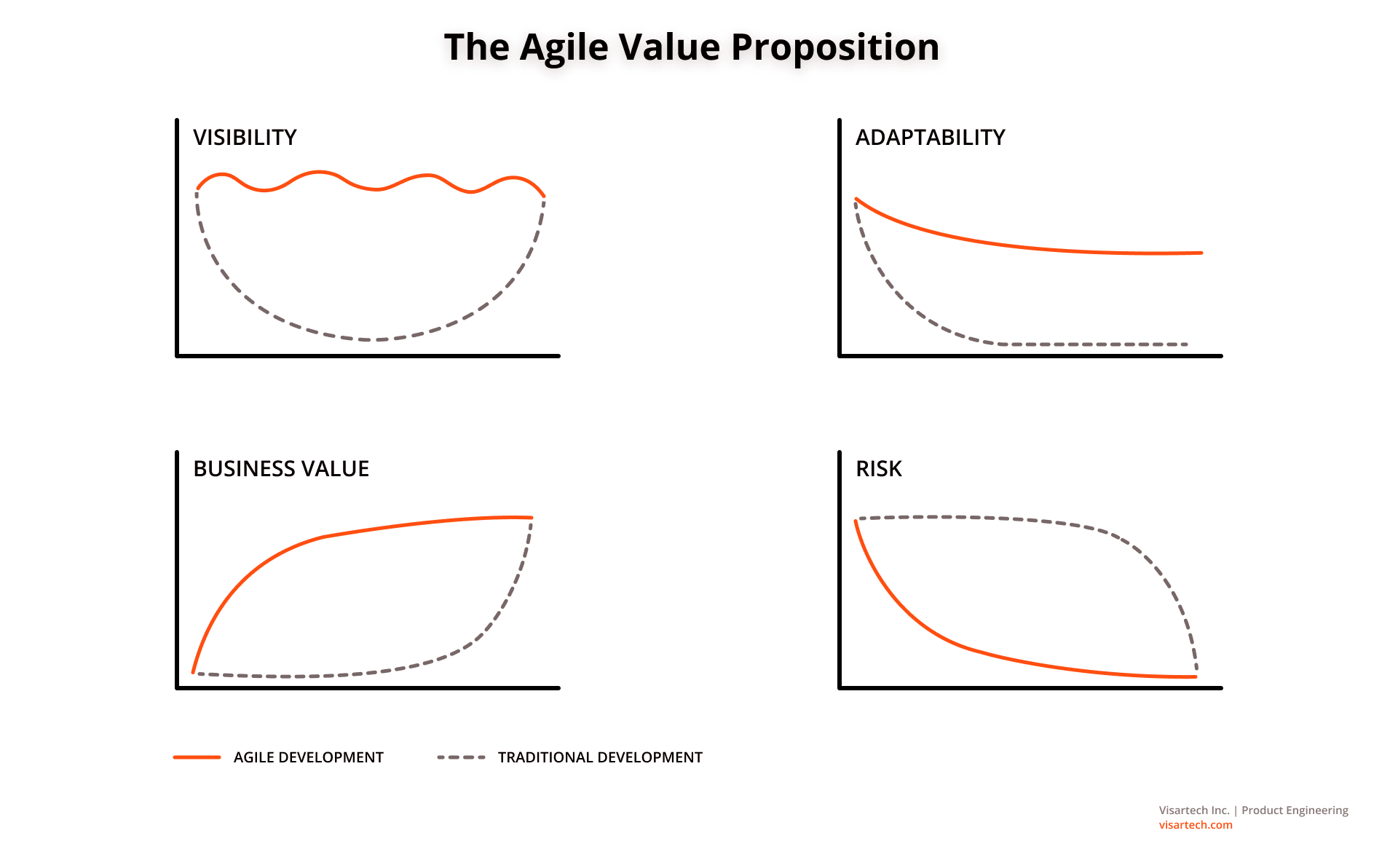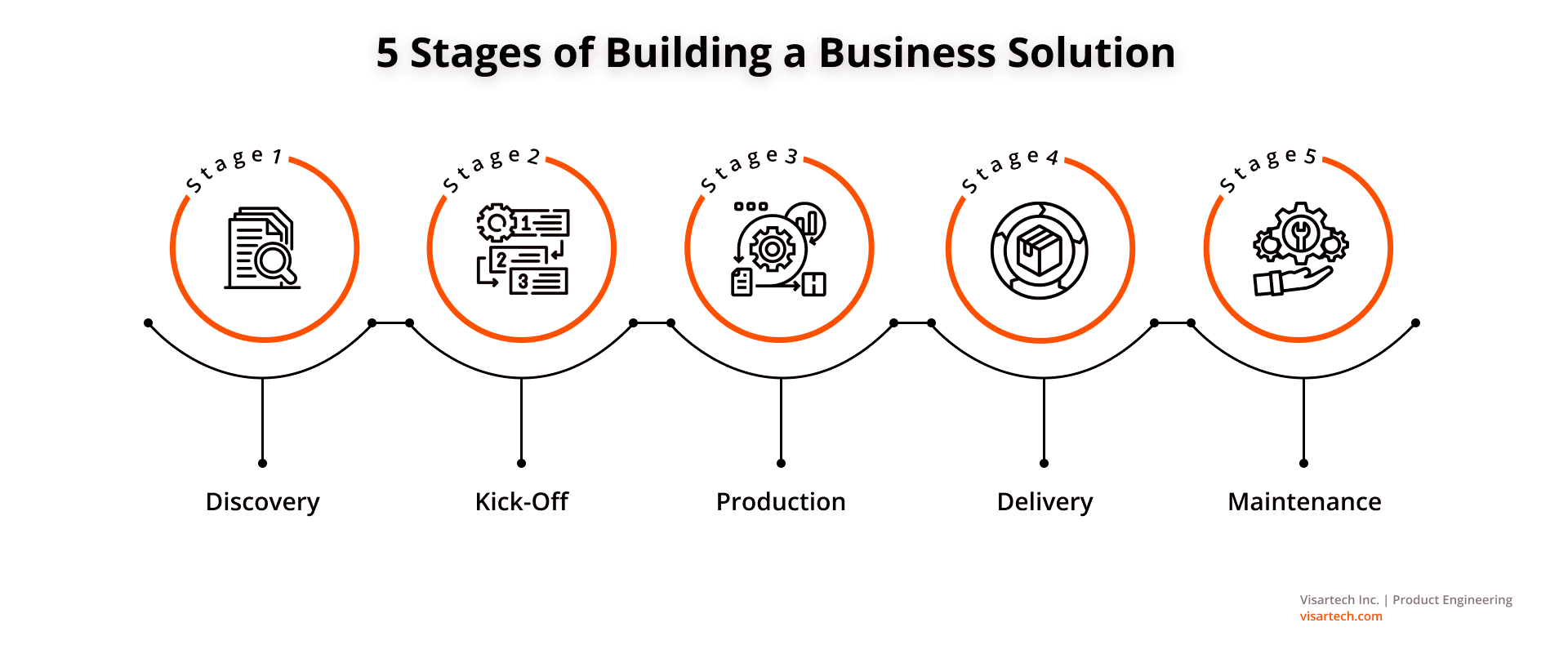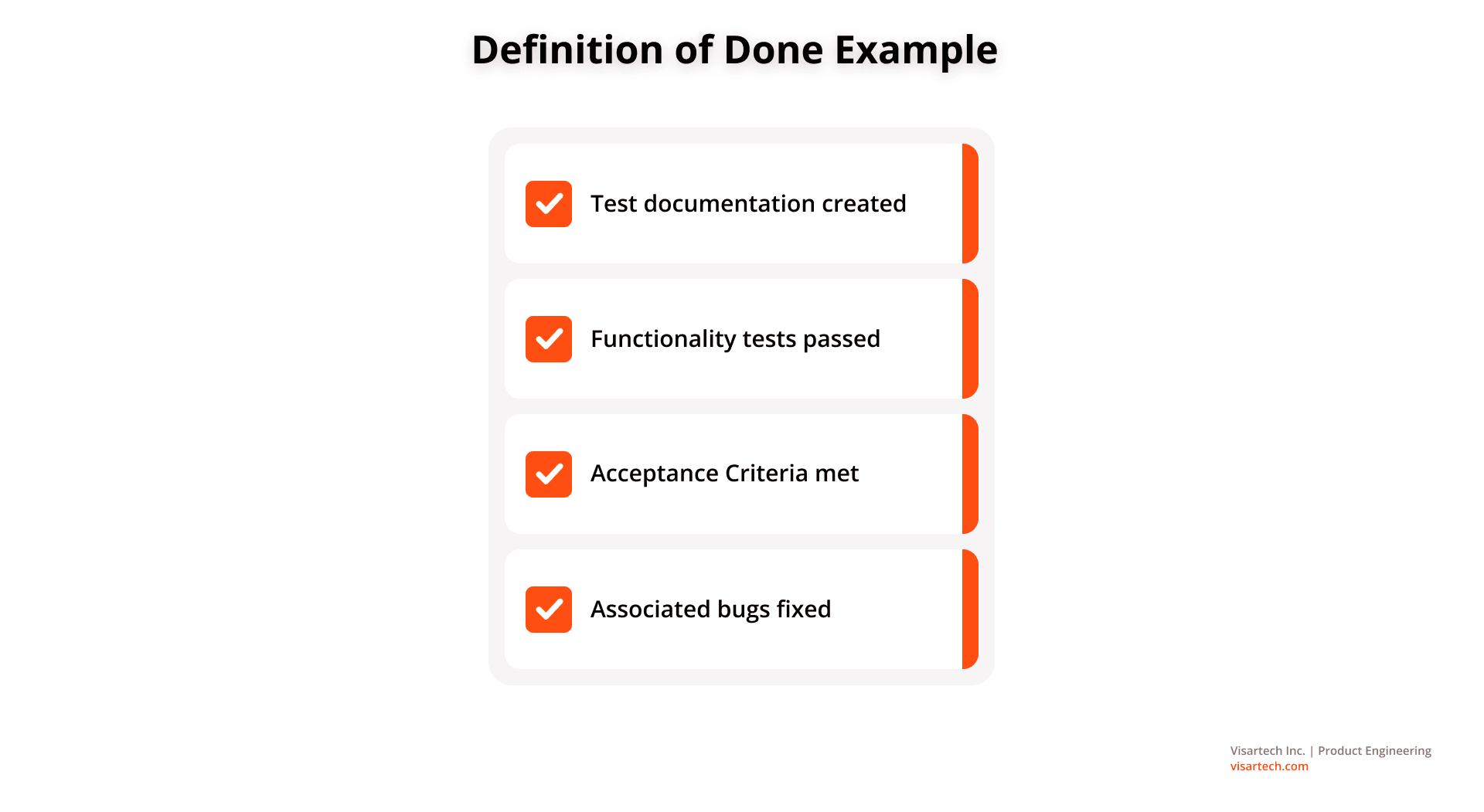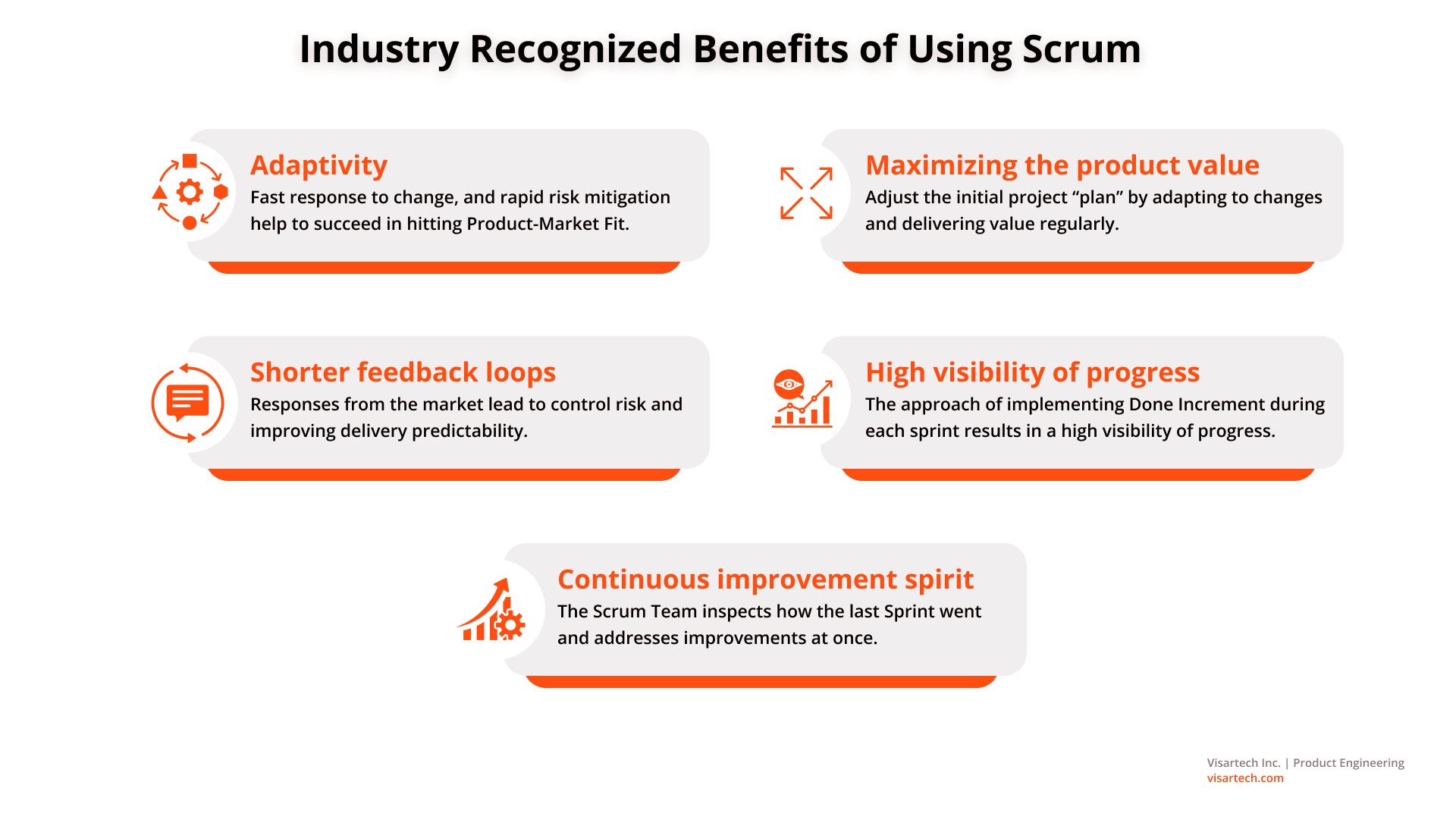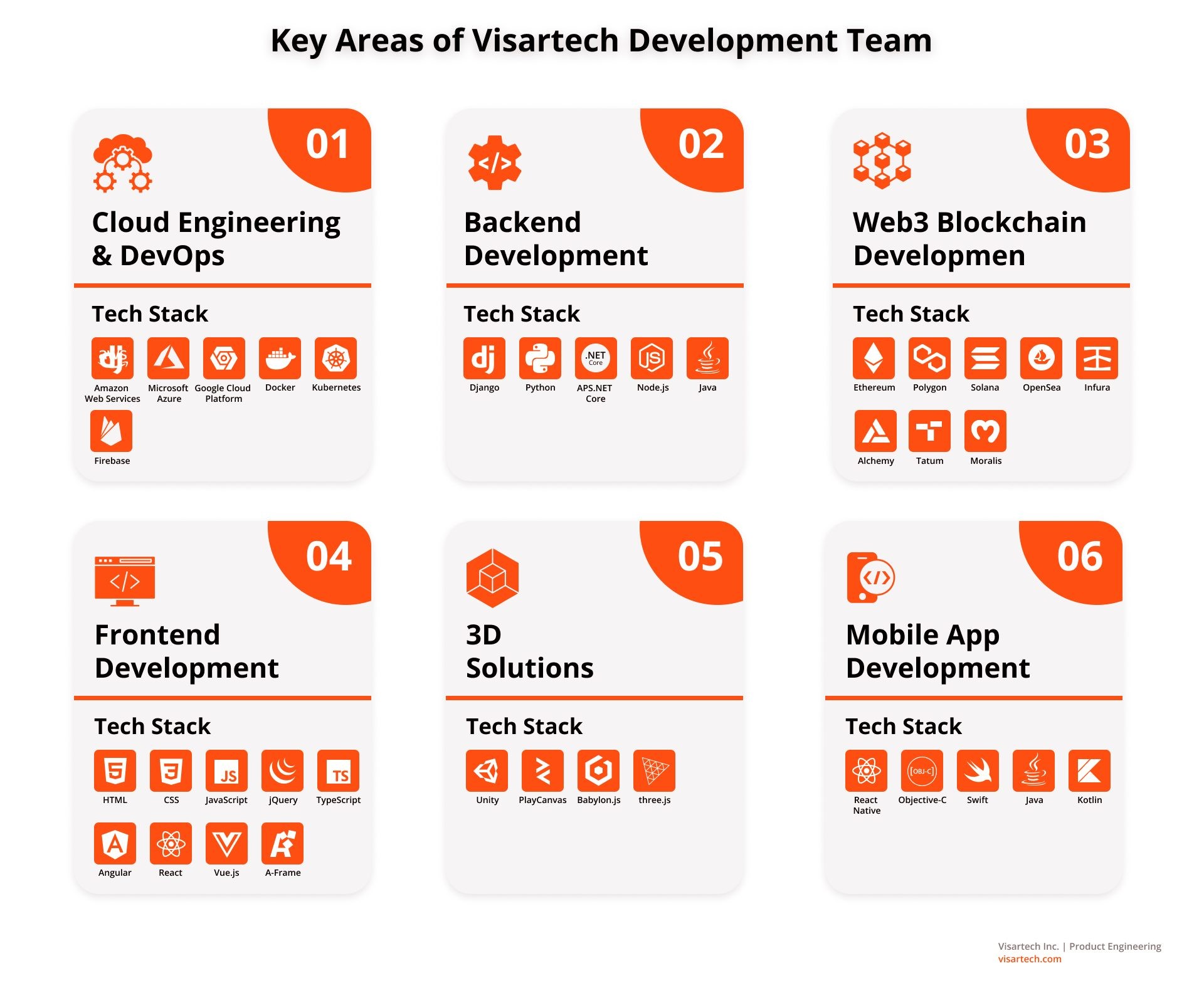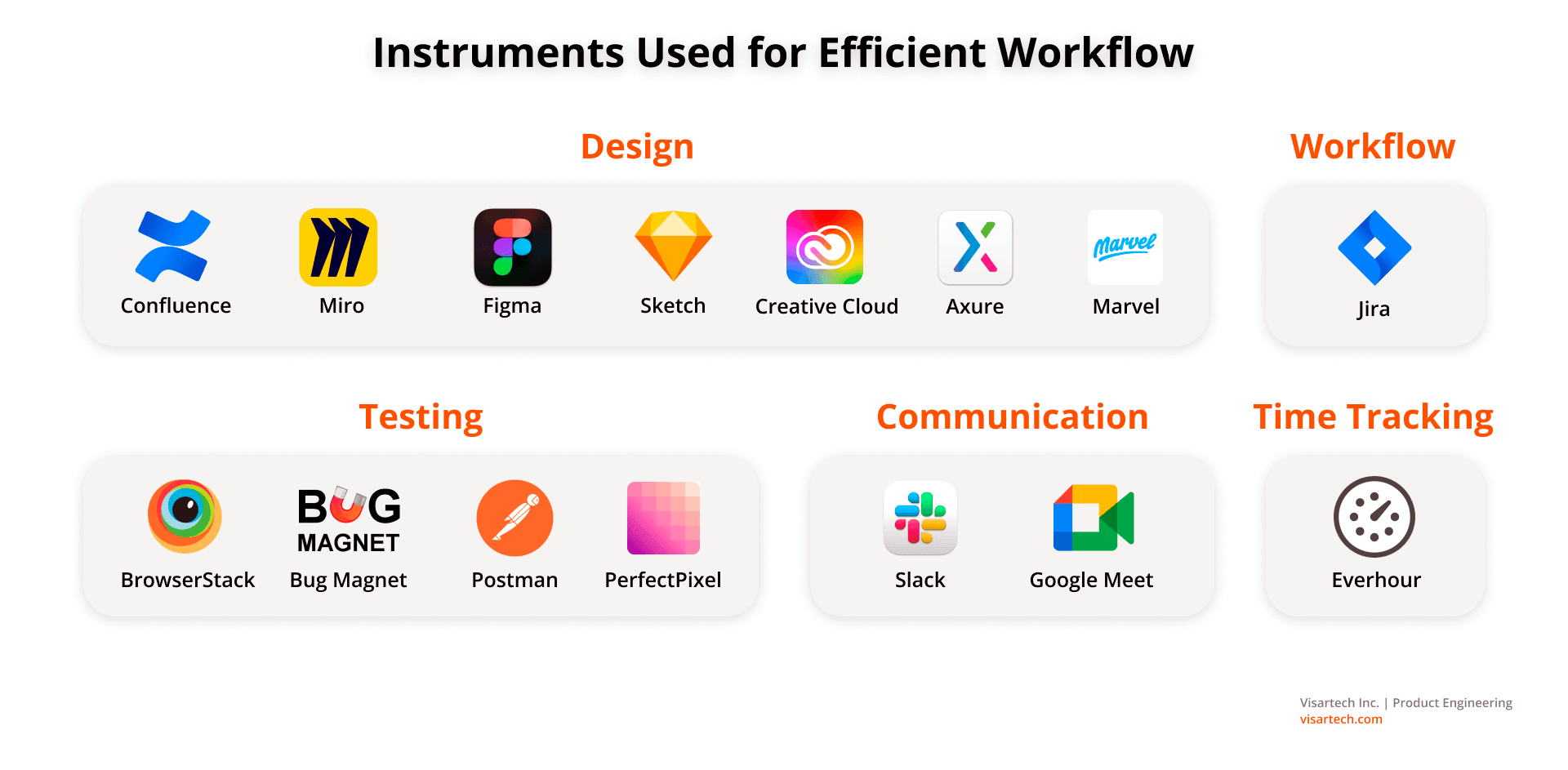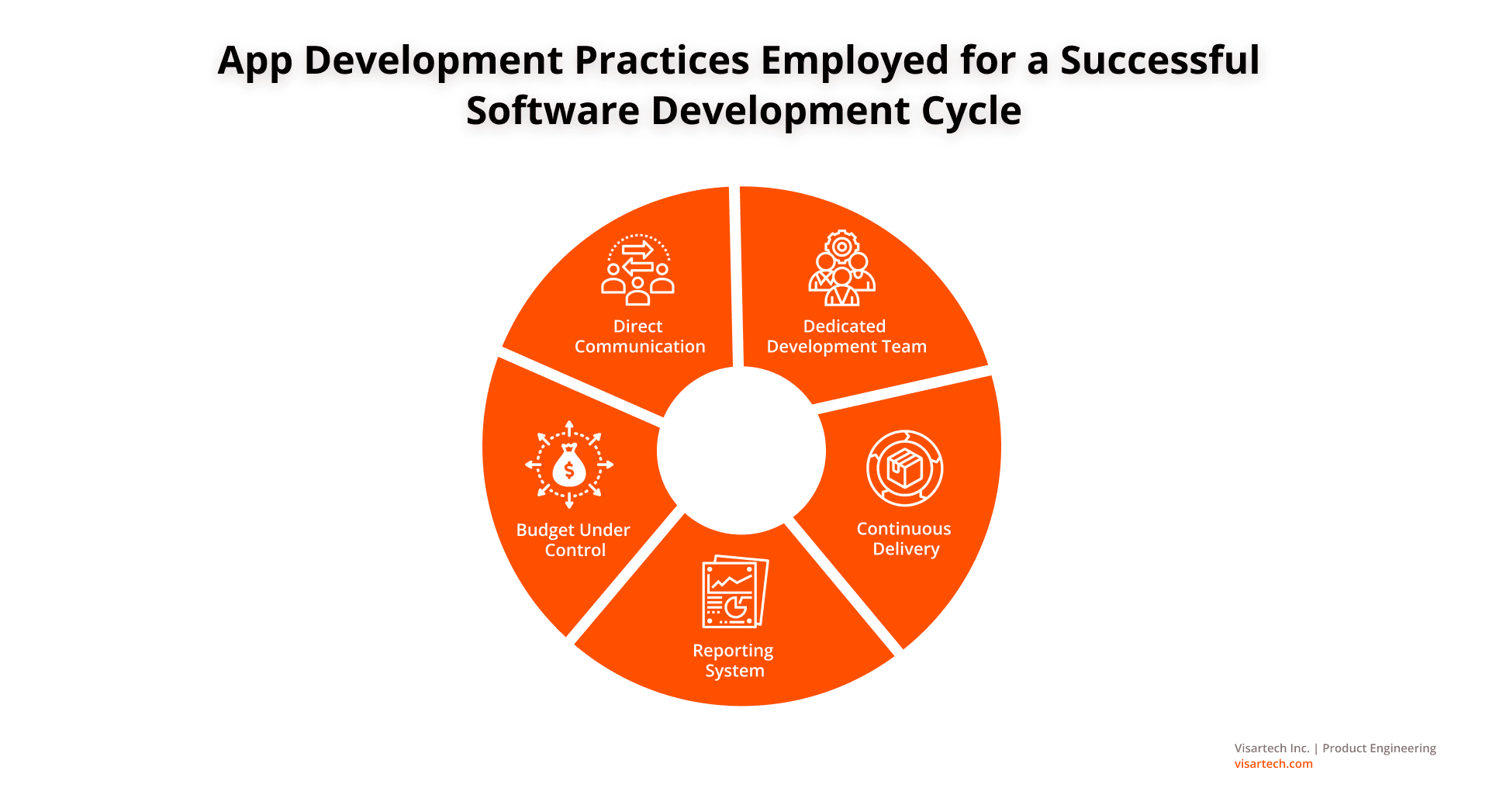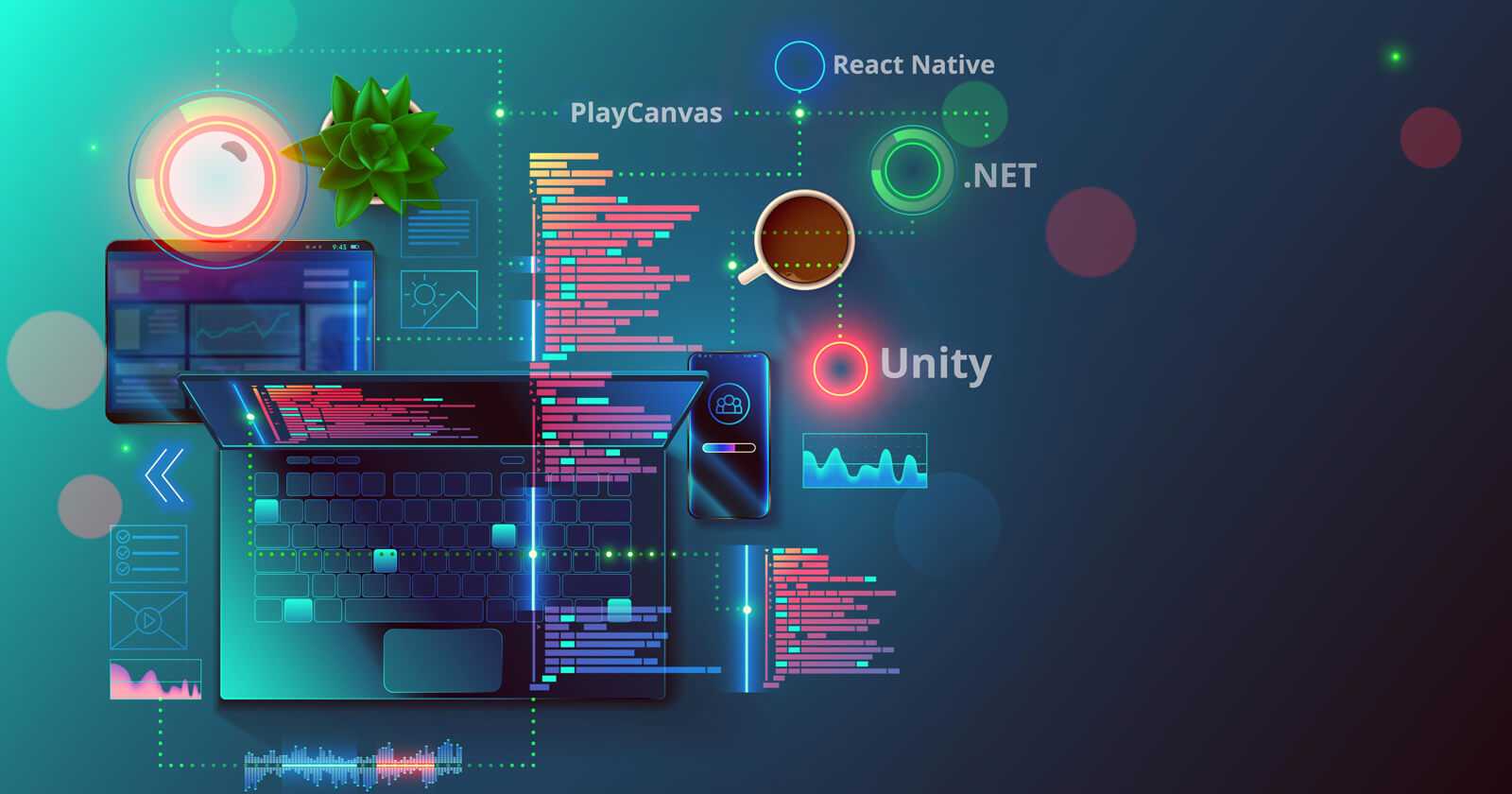Each piece of software we produce undergoes a complex life cycle before it’s finally created and deployed. In tech circles, this process is called SDLC (software development life cycle). A solid SDLC is crucial to the creation of a high-end software solution to satisfy customer needs and expectations.
Efficient development processes are essential for successful business software solutions. The Agile method can make it 54% better, according to Scruminc research. Today’s businesses are more likely to use Agile across the main stages of software development and Visartech is one such company.
Agile is well-recognized among the key market players. This is due to its adaptability and ability to deliver value sooner. The Agile approach improves team collaboration and communication through iterative and incremental development.
In this article, our team will lift the curtain on how things are done at Visartech. You’ll learn more about our custom software development, including an agile development process overview, team, tech stack, and much more. Let’s dive right in, shall we?
SDLC Models and What We Offer
Because of the individual nature of software development projects, the SDLC (Systems Development Life Cycle) models are necessary to create outstanding business solutions that live up to client expectations. They also increase the efficiency with which the teams of app developers can create tech solutions. Each model offers particular strategies for addressing project risks and expenses.
Before you ask, can one go without a software development life cycle? Technically, you can skip this formal process if you’re an amateur who builds an application for yourself. But a real business scenario needs a strong strategy to ensure the software development process is checked from start to finish. Since we cooperate with clients that wish to scale fast and conquer new tech horizons, SDLC is imperative to manage our workflow.
As a rule, SDLC follows the standard procedure of planning, analyzing, designing, implementing, testing, and, of course, maintaining a software program. With a few minor tweaks, our team likewise adheres to these guidelines, which we’ll review shortly.
The software development models are adaptable and, thus, are used across many business strategies, software solutions, and software development services. And here are the two main ones:
- Waterfall
The most commonly used SDLC method for non-complex projects with clear and complete requirements at the beginning of the development that are not supposed to be changed. It is a plan-driven approach, and each of the software development phases here must be completed before the next one begins.
- Agile
The agile lifecycle is your best bet if there are no detailed and complete requirements at the beginning of the development from the client. It’s value-driven, feature-oriented, and involves many changes throughout software solution development. This way of working is also great for close teamwork and tight ties with corporate users.
By finding a software development lifecycle model that fits our strategy best, we can now easily ensure that our application is upscale and can satisfy client demands.
Agile vs Waterfall
As a company firmly established in the industry, Visartech has found its strategies that work best for the entire software development team. It’s crucial to adhere to any kind of reality in the IT sector and stay agile. This gives our team an edge in working with clients from various industries and with different software development requests. Although we mostly employ the Agile approach, we may also use alternative SDLC models based on the uniqueness of each project.
| # | Features/Models | Agile | Waterfall |
| 1 | Process | Adaptive | Predictive |
| 2 | Requirements | Unclear & Unstable | Clear & Stable |
| 3 | Duration | Short but varies | Long |
| 4 | User involvement | High on a project | At the beginning |
| 5 | Success probability | Very High | Good |
| 6 | Team expertise | Very High | Medium |
| 7 | Flexibility to change | Very High | Rigid/Low |
As should be the case with Agile SDLC, our team is cross-functional and self-organized. Each sprint, they produce a software piece that merges with the previous Product Increment. Thus, we can be flexible in our approach to software development by the end of the sprint, and present our work to stakeholders for feedback.
Feedback is a key factor in this case. This helps our tech crew change the solution roadmap during the solution development lifecycle. Namely, the development team makes sure that the app’s functionality satisfies client expectations to the fullest.
With the Agile approach, we can deliver software solutions that help enterprises technically strengthen business development strategies. What does this mean for our clients?
First, our software solutions are developed in swift, iterative cycles (aka sprints), which typically last one to two weeks. This results in gradual little deliveries, each of which builds on the capabilities of the prior one.
Second, using the product-market fit framework we help businesses ensure that their future solution suits the market needs.
Third, Agile software development benefits allow us to:
- focus more on customers’ needs;
- make changes at any development stage;
- facilitate constant cooperation with the development team and the clients.
This is how our team uses SDLC to organize a software development workflow and deliver the final business solution on time and within a reasonable budget.
5 Stages of Building a Business Solution Using Agile Development Life Cycle Approach
Building a standout software solution in today’s competitive market needs a structured approach. From discovering all the project details to delivery and maintenance, each stage of the process plays a crucial role in determining the ultimate success of your software solution.
So let’s take a closer look at the details of this software journey!
Every tactic, though, is unique. Here are five app development stages we follow at Visartech:
Discovery
Our team takes care of understanding the project needs. We talk to the client to figure out the details and plan the tech stack, tools, and team required for the project. At this stage, communication with the client is essential. It makes sure we’re on the same page and know what problem the app will solve.
Each software project we start by figuring out what the client wants to achieve. Then, we figure out how much it will cost and give the client a plan. If the client likes the plan, we sign a contract.
To make sure that both we and the client feel secure, we also sign an agreement (NDA) that keeps any sensitive information confidential. This helps us work well together and keep important details safe.
Read also: 10 Reasons to Write Technical Specifications
Learn what it is and how it facilitates software development
Kick-Off
After signing a contract and defining the Product Goal and possible tech solution with the client, we assign the team. Idea validation gives a better understanding of the budget and timeline here. At this stage of the end to end software development process, all our domain experts band together to manage the project.
Having a tight-knit team with a deep knowledge of the software development process steps is essential for building a successful business solution. We organize all the intra-team work by planning a timeline and holding an intro meeting with a team.
Production
During the production stage, we keep focusing on producing quality Done Increment every Sprint. If the work doesn’t meet the Definition of Done, it can’t be considered as an Increment. The product goes into production when pre-launch testing shows it is ready to go. Production involves setting up servers to host the software, creating a CI/CD pipeline, and protecting software against failures from outside sources. A deployment plan has a role in it as well.
Throughout the production stage, we send builds every two weeks. It keeps our client up-to-date and allows us to make changes in time. The use of the agile SDLC model makes this process simple. Also, we make mandatory progress reports and record updates to see if we’re heading in the right direction.
Delivery
At this point, we can hand over the software solution to the client and distribute the source code once the product meets an acceptable level of quality. Delivery covers several software development steps.
First, we do a beta test on the product before delivering it to a prospective customer. This makes sure it functions properly on a broad scale. If any issues are found, they are fixed by the engineers before the final deployments.
We also ensure the integration of knowledge-sharing during delivery, creating a knowledge base. This is essential for a successful software development process. Along with improving your comprehension, it also encourages teamwork. The sharing of knowledge also provides future team members with a reference point for enhancing the workflow.
Maintenance
The application development process doesn’t stop when the product enters the market. A maintenance mode is necessary to address problems that end users might raise. This includes making any adjustments after the tech solution has been released. For example, managing lingering defects or resolving fresh issues brought on by customer feedback.
Delivering the final solution to our client is not the end of our collaboration. In case any issues arise, we make sure to address them and provide supporting infrastructure. Our team also cooperates with marketing and publishing agencies. This is a great way to scale your business and publicize your product.
How Does The Agile App Development Team Organize Their Work?
Visartech software development workflow is based on the Agile mindset and Scrum framework. It helps us solve the complexity, minimize risk, and speed up time to market software development.
Empirical Process
Living in a dynamic environment means that making expectations about the future can turn into costly mistakes. That’s why we rely on three fundamental principles to get empirical process control.
Transparency involves collecting data, including metrics, feedback, and other experiences, to gain insight into the current situation.
Inspection requires examining the progress made with everyone involved and determining what it means for our goals.
Adaptation empowers us to make adjustments that align with our objectives.
Accountabilities
Building a complete business solution requires seamless partnerships and relationships between the software provider and the client.
Scrum is an efficient, team-oriented approach that is composed of three essential accountabilities:
- Development Team
Visartech’s core dedicated software development team includes many professionals with deep expertise in designing tech solutions. The composition of our team working on the development of innovative ecosystems includes software architects, tech leads, business analysts, designers, software engineers, and QA engineers. They strive to create first-rate solutions that assist in attaining the Product Goal.
- Product Owner
Managing and ordering the Product Backlog, the Product Owner finds ways to make the product’s value better. Thus, it makes our software development process more efficient.
In more detail, his day-to-day responsibilities may include Product Goal crafting, providing summaries and criteria to Product Backlog items, Product Map creation, meetings with developers to discuss all the elements of Product Backlog, taking part in the Validation testing of acceptance, etc. The Product Owner may delegate some of his duties to other members of the development team.
- Scrum Master
The effective performance of the Scrum Team is reliant on the work of the Scrum Master. SM organizes everything so that the development team can deliver and create Product Increments. Additionally, the Scrum Master gets across the ideas of an empirical approach and collaborative culture to the Scrum Team and helps to follow them.
Scrum Events
Sprints are the foundation of Scrum. They give the workers regular moments (generally two weeks) to transform ideas into complete business solutions. Each task is aimed to reach the object of the product. Let’s review these activities in more detail.
Visartech Approach
Sprint 0
This first step is crafting the Product Backlog. It includes requirements detection, refining the MVP scope, and creating UI kit and style.
Although the sprint is only the initial stage, it gives us some outcomes. For example, UI concepts, screen prototypes, user story mapping, and so on. To achieve these outcomes, a team consisting of a UI/UX Designer, BA, PO, QA, and several software development team members may need to be involved.
The Following Sprints
After the Scrum team has established the Product Goal and initial Product Backlog with “enough ready” scope to start Sprint 1, all subsequent sprints start. To be sure that the first increments are high-quality, they determine the Definition of Done. This term means the set of conditions the Increment must have.
Delivering Increments in time is one of our top priorities. So we consider the amount of time needed to make something valuable and form the Sprint length. It is important to note that every Sprint has the same duration which can’t be changed during its realization. Besides, we select a set of ready Product Backlog Items and define achievable and flexible Sprint Goal.
We constantly track our progress during the Daily Standup meeting and make changes to the plan, if necessary. Completion of the Sprint includes the Sprint Retrospective which identifies improvements to increase our effectiveness.
Refining the Product Backlog is an ongoing activity that prepares the scope for upcoming Sprints. To make the quality of the software solution better, we use early and continuous delivery. This allows us to lower the risk of spending money on the wrong things.
The results of the Sprint are provided to the Client by the end of Sprint on Sprint review meeting as well as Sprint result report.
Key Areas of Visartech Development Team’s Activities
Sprint by sprint, our development team creates business-transforming software solutions that encourage enterprise performance lift. To achieve this, we use a carefully selected set of practices and tools that vary depending on the area of our development process.
The main spheres of our development team activities include cloud engineering & DevOps, backend development, Web3 blockchain development, frontend development, 3D solutions, and mobile app development. Let’s take a closer look at them!
Cloud Engineering & DevOps
To hasten the development of SaaS solutions and cloud operations, we assist in achieving effective communication between all product components, reduced procedures, and simple third-party integration. Amazon Web Services, Microsoft Azure, Google Cloud Platform, Docker, Kubernetes, and Firebase are our core tech.
Read also: Budget-Saving Strategies to Optimize Your IT Infrastructure
Discover the best DevOps practices that help to reduce IT infrastructure costs
Backend Development
For enterprise-level applications and consumer-oriented products of any business concern, we provide backends and APIs that are highly secure, scalable, and resource-efficient. The tools that we use are Django/Python, APS.NET Core, Node.js, and Java.
Web3 Blockchain Development
Our clients may take advantage of a completely new method for performing tamper-proof transactions and promoting a user-first mentality thanks to our blockchain services and Web3 experience. Our assets are Ethereum, Polygon, Solana, OpenSea, Infura, Alchemy, Tatum, and Moralis.
Frontend Development
We offer attractive online user interfaces, WebGL solutions, and SPAs that load quickly, are dependable and easy for our clients of every market niche. Here, we use HTML/CSS, JavaScript & jQuery, TypeScript, Angular, React, Vue.js, and A-Frame.
3D Solutions
To create software solutions that delight the end user, our development team focuses on customized 3D development. Modeling realistic visualizations of concepts and products is possible thanks to a carefully selected tech stack. It includes Unity, PlayCanvas, Babylon.js, and three.js.
Mobile App Development
At Visartech, we provide a bundle of tried-and-true agile approaches, design thinking, and user-centered design. It gives us the opportunity for the greatest possible representation of your brand and the ability to reach your consumers on their preferred devices. The technologies we use include React Native, Objective-C, Swift, Java, and Kotlin.
Tools Used in The Agile SDLC: Visartech Choice
The right tooling is essential to any company providing application development services, and so it is for our team. It must include all the necessary apps and platforms for clear communication, and effective time allocation inside the company.
Let us share with you some of the secret weapons that help us keep our software development process productive:
Design
- Confluence
A collaborative wiki workspace that enables our dev team to work more effectively together on crucial projects. This tool saves and organizes all our material.
- Miro
With the help of this collaborative whiteboard tool, we can efficiently manage our distant teams by using digital sticky notes or managing agile processes.
- Figma
A well-known design asset that helps our team create software design with boundless imagination. It includes interfaces for mobile and online devices. This platform for team and individual collaboration enables us to produce and share outstanding results.
- Sketch
Our web designers use this vector graphics tool for making concept pages, icons, and other essential web components. This product design tool has also gained traction among UI and UX designers.
- Adobe Creative Cloud
For all of our creative endeavors, including graphic design, UX design, video editing, social media, and more, Adobe CC offers helpful tools, web application development services, and resources.
- Axure
Due to the high degree of functionality and visual richness, this UX design tool is commonly used for developing wireframes and interactive prototypes. Our designers of web and mobile apps find it particularly beneficial.
- Marvel
A cloud-based platform that lets individuals, groups, and teams of all sizes work together to develop app prototypes in a single workspace. It has mobile support, too.
Workflow
- Jira
We find this software a robust tool for managing our agile SDLC process, particularly under the Scrum framework. It has a Scrum board with a visual representation for managing complicated projects and fostering a collaborative environment.
Read also: How Workflow Management Software Can Power Up Business
Discover how to automate business processes and boost productivity
Testing
- BrowserStack
Instead of maintaining an internal test infrastructure in-house, this tool lets our developers thoroughly test solutions across more than 2500 actual browsers and devices.
- Bug Magnet
A Chrome add-on that gives users quick access to typical software testing issue values and edge situations.
- Postman
Our developers can easily create, distribute, test, and document APIs with this tool. More specifically, they can generate straightforward and intricate HTTP/s queries, store them, and examine the results using this open-source application.
- PerfectPixel
By placing a semi-transparent image over the written HTML and analyzing the results pixel by pixel, this tool helps our engineers and markup designers.
Communication
- Slack
This corporate chat platform helps our team to keep in constant communication with each other. We also use it to inform team members about certain company updates.
- Google Meet
The Visartech team uses this video tool for arranging daily meetings with the team and online video calls with the clients.
Apart from the communication instruments mentioned above, we use Zoom and Microsoft Teams. This allows us to keep convenient collaboration with clients according to their preferences.
Time Tracking
- Everhour
By using this app, we track the work hours of our team or a specific team member (i.e., remote worker tracking), and compile the information into useful, in-depth reports.
What App Development Practices Do We Employ for a Successful Agile Development Life Cycle?
The set of innovative tech stacks and tools for efficient workflow is not all the ingredients of the business-transforming solution. There are also some viable practices that we use to build a team of tech geeks passionate about their job:
Direct Communication
The constant communication is what the interactive nature of the agile SDLC is about. Our team communicates with clients daily. This keeps transparent relationships throughout the workflow and gives us a better idea of what software needs to be developed.
Such a type of partnership implies regular updates on the project, the self-negotiable nature of the web development process, and lifelong learning. All this serves as the source of motivation and, thus, active engagement of our dev team.
Dedicated Development Team
The progress of web app development (or any other type of software) is monitored by our tech specialist. He makes sure the project’s design and integrity are sound.
We value long-term partnerships with our clients, and a dedicated team is a silver bullet that we use across all stages of the software development life cycle. Such a specialized team allows for the complementarity of undefined requirements, promotes effective communication, and suits businesses relying on cloud technologies.
Continuous Delivery
Our main goal is to assure continuous delivery of an app to customers and end users, meeting solution agility. Thus, our approach to building a software solution has a significant impact on the final results of our production efforts. This is why we deploy TBD (trunk-based development) for maintaining the CI/CD pipeline, assuring effective version control, and synchronizing the workflow.
Read also: Trunk Based Development for Continuous Delivery
One practice that helps speed up the development process
Reporting System
To show our clients where the project is headed, we provide the full picture of the planning, progress, and reporting. With the reporting system, we can gather data from databases, compile it into reports, and make better business decisions. Also, we make sure to keep a record of reported software bugs using a bug-tracking system. We also organize and rank related activities to do projects by using task management tools.
Budget Under Control
Any time we engage with startups or established businesses, we provide estimates that are precise, open, and adaptable. This way, our clients pay only for the functionality that is provided. We determine the client’s requirements, learn about their budget, create an estimate, assess the risks, and take out-of-scope costs into account.
Let’s Recap
Modern custom software development companies might find it difficult to succeed within the fast-paced digital landscape. Yet, a well-configured team workflow can save the day and make it workable for companies to successfully develop any business solution.
The effectiveness of the Agile SDLC in producing high-end software that satisfies client requirements is proven by our team and the solutions we offer. But because every project is different, there are a variety of these models to fit each particular software development process.
Creating high-quality business solutions and services is the main objective that defines our workflow at Visartech. As such, knowing how to organize your work and the team is the first step in building an app that matches business goals, resources, and timelines.

